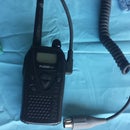Introduction: Soldering Iron Temperature Controller
Once I saw a price for a "soldering station" for 30.00, I decided I could do the same thing 5 times cheaper. I already had my $4 soldering iron, now all I needed to so was be able to change it's standard 30w heat output.
That's right! Anyone whose anyone that solders will tell you, "If you aren't using an adjustable soldering iron you're just a solder burner. I know, I was one of those people with a blazing hot 30w soldering iron that you couldn't properly tin the tip of the soldering iron. You can't keep the solder on there because the temperature exceeds you're ability to keep melted solder in place. It's the difference between a skillet that's 160F with butter on it, than a 450F skillet, the butter just goes crazy, so does your solder, unless you can turn it down.
Step 1: Prerequisites
I love that word, didn't use to pronounce it very well. What you should know before you take this one on is having worked with AC before. A sign you're not ready is if you don't know what AC is. A voltmeter is helpful but not absolutely necessary if you know how to wire an outlet. If you've not done that before, find someone who has, to help you with this. Though it's not vital for this specific project to be wired polarity specific because the soldering iron just heats up. You should wire it properly as a matter of wiring standards.
Parts: Dimmer, dual outlet, housing. If you don't already have a three prong plug you've cut off of an extension cord you'll have to buy it. 3 wires at least 16ga. 14ga is better. 12ga exceeds the necessity for a 15A circuit.
Like I said, if none of this makes sense, work with someone who is more familiar.
Practicing electrical safety (not working with it plugged in already)
1. Break the tab that connects the two outlets on the hot side, the smaller slot. (you should already know which side)
2. Wire the outlet farthest from the dimmer normally. This is done because both outlets aren't going to be controlled by the dimmer. I like to plug my heat gun for shrink tubing in the top outlet.
3. Connect the lead from the dimmer to the power you wired to the first outlet. Attach the wire that remains from the dimmer to the hot side of your remaining outlet, to control soldering iron regulation.
If you get one of those dimmers that has an on/off if you press it in, can fool you into thinking it doesn't work. If you're not getting voltage in your regulated outlet, press the dimmer in again, you should be set.
I found the the lowest and highest setting on the dimmer, then drew a line on the dimmer knob afforded me a reference to see how much the heat is turned up. Usually half way is sufficient for smaller wire soldering 18 to 22ga wire.
Happy temperature controlled soldering you wired yourself for about 6 dollars.













